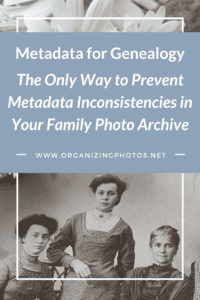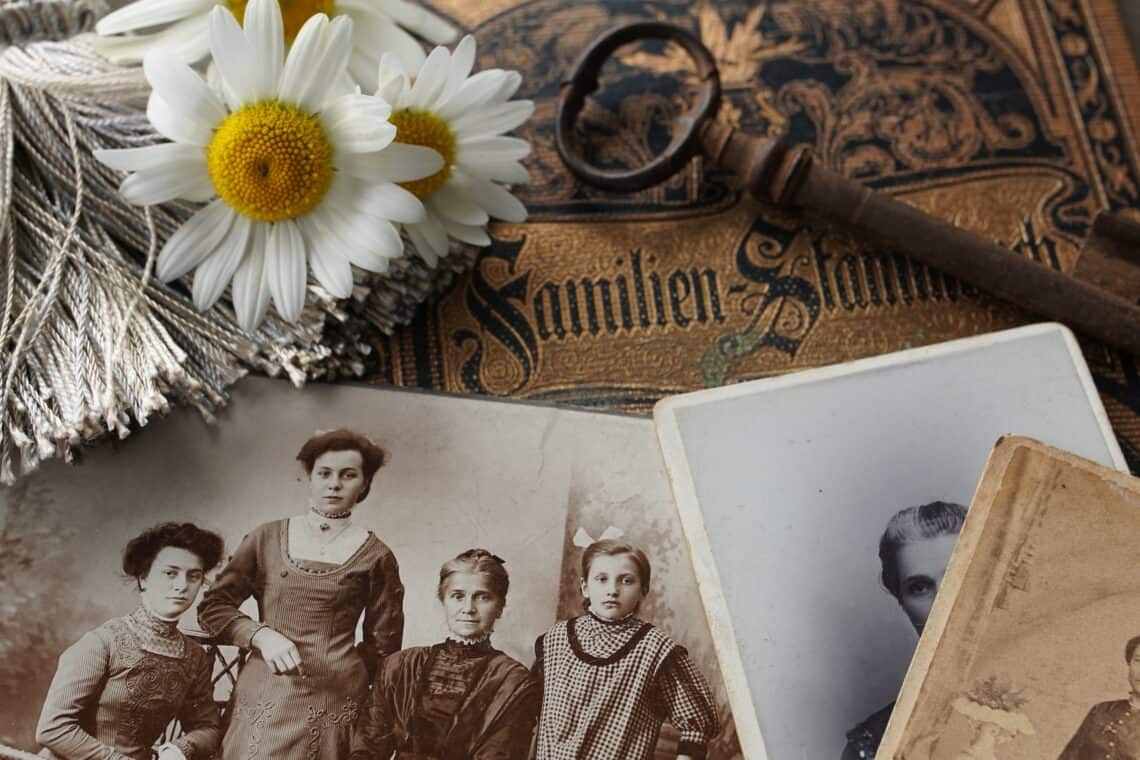Metadata for genealogy…ah, it’s a fun topic, isn’t it? What do we need to consider in our family photo archives? What naming conventions should we use and why? How does it all fit together? That’s exactly what we’re chatting about in this forthcoming blog series. As you embark on your digital organizing journey, you’re no doubt going to have a multitude of questions. It’s only natural. The learning curve in any new endeavor can be overwhelming and confusing. But don’t worry – we’re here to help! Start pinning this series now, so you can start strategizing how to prevent metadata issues in your own photo archive!
Where to Start?
Genealogy is a fascinating pursuit, and we (as enthusiasts) often spend countless hours researching our family’s history to understand where we came from and who our ancestors were. We puzzle together the stories using records, and if we’re lucky enough, photos.
But how do we communicate what we have found to others? How do we ensure that they know who is who? Well, writing and compiling books and reports is one way, but metadata is the other. In fact, anyone who has photos in their possession (whether a genealogist or not) needs to understand how to approach metadata for genealogy – the right way.
Let’s start with some project management basics.
Each project, no matter what type of project it is, has a planning phase. Most people skip it and therefore miss out on much of the strategizing they need to do in order to successfully complete their project. I don’t want you to make that mistake.
Read that last sentence again because I mean it. My whole business is built around the idea of helping people finish what they start, so project management is a big passion of mine.
What’s Your Organizing Plan of Attack?
The former paragraph begs the question: What’s your plan of attack? If you don’t know the answer to that, you’re gonna have a hard time prioritizing your project.
One of the things we teach our students in DPO PRO: The Ultimate Photo Organizing Masterclass is to invest time in the planning process, so that the rest of the project goes smoothly.
Most people aren’t able to embed metadata into their photos quickly because they’re unclear on some of these details, like what they’re supposed to type into those fields. They hesitate because they don’t want to make a mistake and start over again. That, my friend, is a classic project management trap. If you have completed the planning phase of your project, you know those answers. If you don’t, it’s back to the drawing board until you do.
The skill of entering metadata is actually quite straightforward once you have decided what information to use, but it’s those decisions around what to embed that are hard. That’s where most people get stuck. Let’s avoid that, shall we?
… But First, What is Metadata?
Before we get to the solution, let me tell you a little bit about why we need to care about metadata, and why it’s worth taking the time to learn about it.
Metadata is data that describes and gives information about other data. In the case of digital photographs, this means the information that is embedded in the digital photo itself and provides details about the image.
With printed photographs, we would write on the back of them, put them in envelopes and take notes there, or put them in albums with captions. Unfortunately, we can’t do that with digital photos. Yes, there are ways to get around it, for example creating a People Index, or adding visual captions, but for our photos to be truly protected, we need to learn how to embed metadata correctly. Metadata for genealogy is especially tricky because of the number of people we’re usually dealing with in one archive.
Technical vs. Story Metadata
There are different types of metadata, but you don’t need to learn all of it in order to be efficient. In photo organizing, we mostly focus on two types: technical (EXIF) metadata and story (IPTC) metadata. For a primer on some of the basics, check out Metadata and Photos, Part 1: Simpifying the Concept and Metadata and Photos, Part 2: Let Efficiency Rule!
Technical metadata is very straightforward because it describes the details surrounding the creation of the image, for example the date it was taken, and the camera’s ISO settings at the time of the click. The camera can figure out most of that on its own, and automatically apply it to each image we take. This is the easy part. It’s mostly done for us – with the main exception being that sometimes the dates get messed up (for example, when we scan or export photos).
IPTC metadata (or what we affectionately call “story” metadata) is different. That’s the information that describes what’s going on in a photo, like why it was taken and the names of the people who are pictured in it. Your device doesn’t know that information. Only you do. That’s why we need your input.
Story Metadata = Context
But what about AI, I hear you asking? Why should I bother adding metadata to my photos when Google auto-tags my photos?
Good point, but that’s for a different purpose. In my mind, keywords are for finding photos, not for telling their stories. Sure, Artificial Intelligence (AI) can identify some generic stuff here and there (like recognizing a dog, a cat, or a monument), but it’s certainly not able to understand that you went to an anniversary dinner at a certain restaurant because that’s where you met your spouse. That’s not a “taggable” piece of information. Basic facts, sure. Stories and context, no.
Stories are what communicates the context of why a photo is important. Without that type of backstory, the photo eventually loses its meaning and gets tossed out. If you think about it, the same scenario holds true for other physical possessions you own – once the meaning is gone, there’s no reason to hold onto it. That’s not the fate we want for our photos. The key to communicating their meaning is to embed the stories correctly.

I’m a Perfect Pinnable!
Your First Assignment: Creating a Solid Metadata Strategy
So now that you understand why it’s important to use metadata correctly, let me continue to my next point, and the solution to this conundrum. Once you have decided that you want to embed metadata (headlines, captions, keywords, and so on) into your photos, you have to create a solid metadata strategy, so you know how to go about it. You do this for the sake of consistency, to iron out the details, and to document for others what choices you made and the implications of them. This is the planning phase of your project, which always comes first.
Yes, you heard that right. Your strategy should be to create a strategy. In genealogy as in photo organization, and from business operations to life in general, clear communication takes care of most of your woes – metadata or otherwise.
We always have to determine the best approach to a project because it makes your actual archiving go so much faster. After all, if you haven’t asked yourself any of the crucial questions, how are you supposed to know the answers? You can’t, and that’s where the inconsistencies live. You prevent them by completing the first phase of the project management cycle: the planning stage.
The Overcomplicated File Name
The solution that many hobbyists deploy to solve their metadata identification issues is what we refer to in the industry as “the overcomplicated file name.” It looks a little something like this:
September4th1923-grampaEDandHISWIFEedna_backyard-party-GreenBay_Wisconsin-photofromUncleLouis.jpg
Now imagine another hundred thousand images just like it. It’s a text wall of horror.
This is what happens when you don’t yet understand how metadata for genealogy is supposed to work. While there is information in there, this is just not a good strategy – for several reasons. It’s not consistently formatted. The file name is hard to read. It’s very subjective, and worst of all, it doesn’t tell the whole story. In short, it’s not very useful. Yes, file names should be descriptive, but they should also be short and sweet. If you make them too long, they error out.
Is this approach better than nothing? Perhaps… but to be honest, naming files like this is not worth your time. All that information you want to cram in belongs in other fields, so we just have to understand which ones. That’s easy enough to learn.
“But I’m Not a Pro…”
“But I’m not a pro…do I really have to learn this stuff?” Yeah, I think you should.
Pros and non-pros alike should create a strategy and document it because that’s how you remember where you left off. Organizing your digital photos and family history archive is a big project, and you cannot possibly complete it in one sitting. It takes a bit of time, and you have to stop and start a few times.
If you don’t have any guidelines for yourself, and if you make no decisions on how to approach the project, you will soon find yourself starting over. Again and again. That’s a waste of time. Documenting your process may take an extra minute, but it saves you hours down the line. Spend some time learning how to properly identify and classify your photos, so that you can do it right the first time, i.e. ONCE, and not have to start over again and again.
What to Include in Your Family Archive Metadata Strategy
So what should you include in this strategy then? Well, a few things.
A good metadata strategy should consider various scenarios for telling the stories of the photos, including guidelines on how to name people, places, and events. In short, your documentation should present the story about how the family archive came about, your metadata strategy, and why you made the choices you made when implementing it.
We have recently had several students – both from Searching Sweden and from DPO PRO – create flawless instruction manuals for themselves, and they all said pretty much the same thing. “Wow, now I know exactly what I need to do next.” This type of planning avoids ambiguity because it forces you to create consistency, and that is extremely valuable. It’s what guarantees the success of the project as a whole, and make the rest of it go smoothly.
Leaving a Legacy the Right Way
It’s my goal that this article has highlighted for you why it’s important that you strategize your metadata approach. I can think of no better way to spend your time to ensure that you accomplish your goal of leaving a legacy. We need to use clear communication, so that our metadata efforts pay off and we get the right information passed on to the right people. Simple as that.
By learning how to embed metadata correctly and documenting it, you can ensure that your photos and family history archive are organized and preserved. A well-organized and properly labeled archive will help communicate your family stories for future generations.
Need to Learn How to Strategize?
If you’re interested in learning more about creating your own metadata strategy, consider enrolling in our Metadata for Genealogy Workshop. We held it last year during family history month, and the replay is available for anyone who may have missed it. See the preview below.
This is by far our most popular workshop. In it, you’ll learn exactly what IPTC metadata fields to use, and what to consider when putting together your own family archive metadata strategy (simple template included). Naturally, all of my recommendations are in there too, so you have references and a place to start.
Above: Watch a sneak peek of our Metadata for Genealogy workshop on Youtube!
For more in-depth help that starts from the absolute beginning, consider joining us in our full course DPO PRO: The Ultimate Photo Organizing Masterclass. That’s where we strategize together, and help you through each step of the photo organizing process. Bonus: When you enroll, you also get the Metadata for Genealogy workshop completely free (as a little bonus) – for a limited time!
Don’t miss out on this opportunity to learn how to preserve your family’s stories and information. Start strategizing your project properly today, so that you can communicate it tomorrow. Your descendants will thank you. Promise.






Bruce G Lightfoot
July 24, 2023 at 11:19 pmI love that you left off the “IN” part of inconsistencies in your link to get to your site and article! It reinforces the point that “fat-fingered-errors” are often the hardest to find because your eyes and mind “know” what you meant to say, but a search engine cannot pick it up when needed.
Hazel Thornton
July 25, 2023 at 10:04 amCaroline, I loved your Metadata for Genealogy class! Have I made the time to implement what I learned? Noooo! Am I glad to see this blog post (as a reminder), and do I look forward to subsequent posts on this topic? Yessss! Thank you!
Caroline Guntur
July 25, 2023 at 11:20 amGlad to hear it, Hazel! I thought it was time for a little refresher on the topic! 🙂